I want my my 21 lines of data on the same graph to be more interpretable with the Legend. For instance, perhaps I could make every other legend entry / line be displayed with dashes instead of a continuous line. My mixed use of Seaborn and Matplotlib is confusing me - I'm not sure how to get the dashes in there in an alternating way.
products = list(data_cleaned.columns)
print('products: \n',products)
for i, product in enumerate(products):
subset = data_cleaned[data_cleaned[product]>0][product]
sns.distplot(subset,hist=False,kde=True,kde_kws={'linewidth':3},label=product)
if i%2 == 0:
plt.plot(subset,'-', dashes = [8, 4, 2, 4, 2, 4])
sns.set(rc = {'figure.figsize':(25,10)})
#sns.palplot()
palette_to_use = sns.color_palette("hls", 21)
sns.set_palette(palette_to_use)
#cmap = ListedColormap(sns.color_palette().as_hex())
plt.legend(prop={'size': 16}, title = 'Product')
plt.title('Density Plot with Multiple Products')
plt.xlabel('log10 of monthly spend')
plt.ylabel('Density')

